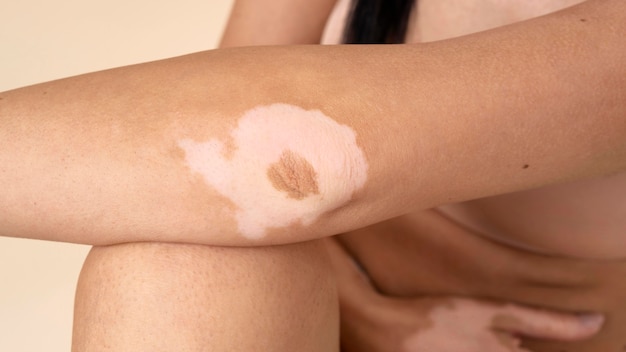
Birthmarks have fascinated humans for centuries, with their presence often shrouded in myths and legends. These unique skin features can come in various shapes, colors, and sizes, including the mysterious white birthmark. In this article, we will delve into the enigmatic world of white birthmarks, seeking to understand their meaning, causes, and possible treatments.
Understanding Birthmarks
Before we explore white birthmarks in depth, let’s first understand what birthmarks are. Birthmarks are localized skin blemishes that are present at birth or appear shortly thereafter. They come in various forms, resulting from differences in pigmentation, blood vessels, or other skin structures.
Types of Birthmarks
Birthmarks are generally categorized into three main types:
3.1. Pigmented Birthmarks
Pigmented birthmarks are characterized by a change in skin color. They can be brown, black, or even blue. Common examples include café-au-lait spots and moles.
3.2. Vascular Birthmarks
Vascular birthmarks are caused by an abnormal formation of blood vessels. They often appear as red or pink marks, such as port-wine stains and hemangiomas.
3.3. White Birthmarks
White birthmarks, on the other hand, exhibit a lack of pigmentation. They are often paler than the surrounding skin, leading to their distinctive appearance. Understanding what a white birthmark means is crucial to many individuals who have them.
What Does a White Birthmark Mean?
White birthmarks, also known as hypopigmented birthmarks, can take on various forms. The meaning behind a white birthmark depends on its specific type. Here are some common varieties:
4.1. White Birthmark Varieties
- Nevus Depigmentosus: This is a permanent white birthmark caused by the absence of melanin in certain areas of the skin. It is often present from birth and does not change in appearance over time.
- Nevus Anemicus: This type of white birthmark results from a lack of blood flow to specific skin areas. It can appear as pale patches and is usually not associated with any health concerns.
- Piebaldism: Piebaldism is a genetic condition that causes white patches on the skin and hair. It is often present at birth and can affect the forehead and abdomen.
The meaning of a white birthmark largely relates to its underlying cause. While many white birthmarks are harmless, they can have varying impacts on an individual’s appearance and self-esteem.
Causes of White Birthmarks
White birthmarks can be attributed to several factors. These may include genetic mutations, the absence of melanin, or reduced blood flow to certain skin areas. In the case of piebaldism, specific genetic mutations lead to the characteristic white patches in affected individuals.
Diagnosis and Identification
Identifying white birthmarks is typically straightforward, as their lack of pigmentation makes them stand out. However, it’s essential to consult a healthcare professional if you notice any unusual skin markings to rule out any underlying medical conditions.
Treatment Options
The treatment for white birthmarks largely depends on the type and individual preferences. Here are some common approaches:
7.1. Medical Approaches
In some cases, medical interventions like laser therapy or topical treatments may be recommended to improve the appearance of white birthmarks.
7.2. Cosmetic Procedures
Cosmetic procedures, such as tattooing or skin grafting, can also be considered to match the affected area’s color with the surrounding skin.
Can White Birthmarks Be Prevented?
Preventing white birthmarks is not always possible, as many are genetic or occur during fetal development. However, protecting your skin from excessive sun exposure can help prevent some types of birthmarks, including pigmented ones.
Living with White Birthmarks
Living with white birthmarks can be a unique experience. Some individuals embrace their birthmarks as a part of their identity, while others may seek treatment to reduce their visibility.
Emotional Impact
The emotional impact of white birthmarks can vary from person to person. Some may feel self-conscious, while others view their birthmarks as a distinguishing feature that makes them unique. It’s important to offer support and understanding to individuals with birthmarks.
Conclusion
In conclusion, understanding what a white birthmark means requires considering the specific type and its underlying causes. White birthmarks come in various forms, and while they may not be preventable in many cases, there are treatment options available to address their appearance. Ultimately, the significance of a white birthmark lies in the eye of the beholder, as it can be embraced as a unique part of one’s identity.
FAQs
1. Are white birthmarks common? White birthmarks are relatively uncommon, with their prevalence varying depending on the specific type.
2. Can white birthmarks fade over time? Some white birthmarks, such as Nevus Depigmentosus, are permanent and do not fade. Others may become less noticeable with age.
3. Do white birthmarks pose health risks? In most cases, white birthmarks are harmless and do not pose any health risks.
4. Can white birthmarks be covered with makeup? Yes, makeup can be used to cover white birthmarks temporarily for cosmetic reasons.
5. Is there a cure for white birthmarks? There is no universal cure for white birthmarks, but various treatments can help improve their appearance. Consult a dermatologist for guidance.
